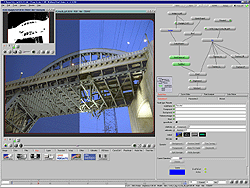|
|
ANIMATION WORLD MAGAZINE - ISSUE 5.12 - MARCH 2001
|
The Technology Circle
Proprietary Needs In fact, there are some large houses where almost all of the software is proprietary and there are some major advantages in this. Proprietary software can save money and time for large effects companies. They've been working so long with their own product that they've built infrastructures such as file formats, geometry formats and image formats around it. For better or worse, they're married to their own proprietary software and it's difficult for them to break away and use a non-proprietary system. Another nice thing about proprietary software is that one can just walk into the office next door and ask a programmer to write something up really quick -- a cool plug-in or some other nice application. There's no waiting, or required detailed explanation necessary. Plus, if you are at ILM or another powerhouse, you probably have some of the brightest minds at your disposal.
Rachel Dunn, one of Digital Domain's top 2D composite artists with credits such as Dante's Peak, Fifth Element, Red Planet, Titanic, The Grinch and Super Nova, explains: "If a studio can afford to write custom software they will because writing their own proprietary software gives them the exact features they need in order to do their job. Most store bought software is written for a broad consumer market. Software companies are trying to make everyone happy. The larger studios don't need that. They custom tailor their proprietary software for their own in house artists." "Our proprietary software Nuke is very powerful. We have about 10 or 12 guys writing software for Digital Domain. A lot of the software we write is translation. We take store bought software and write links to it so it will work with Nuke. So we can get Alias|Wavefront's Maya to work with Houdini, to work with Softimage, to work with Ultimatte and so on and so forth. We can take a blue screen model and read it through five different software packages to get what we need." "We at DD find ourselves bouncing back and forth between quite a few different software packages when we're doing compositing because some packages do better than others on certain things. We will bring an image through a whole chain of software packages just to massage it into the shape we want. The artists and managers at Digital Domain really evaluate the software carefully because there's a whole lot stuff out there you can waste your money on."
Enter the Boutique
|
||||||


